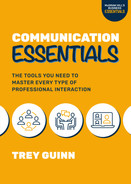Notes
Chapter 1
1. Duck, S. W. Meaningful Relationships: Talking, Sense, and Relating. Thousand Oaks, CA: Sage Publications, 1994.
Chapter 2
1. Watzlawick, P., J. Beavin Bavelas, & D. D. Jackson. Pragmatics of Human Communication: A Study of Interactional Patterns, Pathologies, and Paradoxes. London: W.W. Norton, 1988.
2. Pietromonaco, P. R., & N. L. Collins. “Interpersonal Mechanisms Linking Close Relationships to Health,” American Psychologist. U.S. National Library of Medicine, September 2017. https://pubmed.ncbi.nlm.nih.gov/28880100/.
Chapter 3
1. Jenkins, R. Social Identity. New York: Routledge, 2014.
Chapter 4
1. Brody, J. E. “Personal Health,” New York Times, August 19,1992. https://www.nytimes.com/1992/08/19/health/personal-health-922392.html.
Chapter 6
1. Seinfeld, J. Is This Anything? New York: Simon & Schuster, 2020.
2. Dweck, C. S. Mindset: The New Psychology of Success. New York: Random House, 2006.
Chapter 8
1. Kennedy, T. “Faith, Truth and Tolerance in America,” Liberty Baptist College, filmed October 3, 1983. https://www.Americanrhetoric.com/speeches/tedkennedytruth&tolerance.htm.
2. Gehrke, P. J., W. M. Keith, D. Beard, & G. Bodie. “Listening Research in the Communication Discipline,” in A Century of Communication Studies: The Unfinished Conversation. New York: Routledge, Taylor & Francis Group, 2015.
3. Brownell, J. (1994). “Teaching listening: Some thoughts on behavioral approaches,” Business Communication Quarterly, 57, 19–24.
Chapter 9
1. Markels, A. (2006). “Turning the Tide at P&G,” US News. Posted 10/22/06.
Chapter 10
1. Fullwood, C., & G. Doherty-Sneddon. (2006). “Effect of Gazing at the Camera During a Video Link on Recall,” Applied Ergonomics, 37(2), 167–175.
2. Conway, C. A., B. C. Jones, L. M. DeBruine, & A. C. Little. (2008). “Evidence for Adaptive Design in Human Gaze Preference,” Proceedings. Biological Sciences, 275(1630), 63–69. https://doi.org/10.1098/rspb.2007.1073.
Chapter 11
1. McLuhan, M., & Q. Fiore. (1967). “The Medium Is the Message,” New York, 123(1), 126–128.
Chapter 13
1. Fang, L., G. A. van Kleef, & D. A. Sauter. (2018). “Person perception from changing emotional expressions: Primacy, recency, or averaging effect?,” Cognition & Emotion, 32, 1597–1610.
2. Bergeron, J., J. M. Fallu, & J. Roy. (2008). “A comparison of the effects of the first impression and the last impression in a selling context,” Recherche et Application en Marketing, 23, 19–36.
Chapter 15
1. Guinn, T. (2016). “Friendship Work,” About Campus, 20(6), 23–26. https://doi.org/10.1002/abc.21221.
2. Segrin, C., & S. A. Passalacqua. (2010). “Functions of loneliness, social support, health behaviors, and stress in association with poor health,” Health Communication, 25(4), 312–322. https://doi.org/10.1080/10410231003773334.
3. Thibaut, J. W., & H. H. Kelley. The Social Psychology of Groups. New York: John Wiley & Sons, 1959.
4. Walster, E., E. Berscheid, & G. W. Walster. (1973). “New directions in equity research,” Journal of Personality and Social Psychology, 25(2), 151–176. https://doi.org/10.1037/h0033967.
5. Stafford, L. (2011). “Measuring relationship maintenance behaviors: Critique and development of revised relationship maintenance behavioral scale,” Journal of Social and Personal Relationships, 28, 278–303.
Chapter 16
1. Hocker, J. L., & W. W. Wilmot. Interpersonal Conflict (11th ed.). New York: McGraw Hill, 2022.
2. Guinn, T. (2018). “Two Action Items for Building Consensus and Improving Workplace Relationships,” The Department Chair, 28(4), 6–7.
3. Gottman, J. M., & N. Silver. The Seven Principles for Making Marriage Work. New York: Harmony Books, 2015.
4. Horan, S. M., T. D. Guinn, & S. Banghart. (2015). “Understanding relationships among the dark triad personality profile and romantic partners’ conflict communication,” Communication Quarterly, 63(2), 156–170.
5. Lencioni, P. The Advantage: Why Organizational Health Trumps Everything Else in Business. San Francisco: Jossey-Bass, 2012.
6. Kantor, J., & D. Streitfeld. (2015). “Inside Amazon: Wrestling big ideas in a bruising workplace,” New York Times, 15(08), 1–19.
